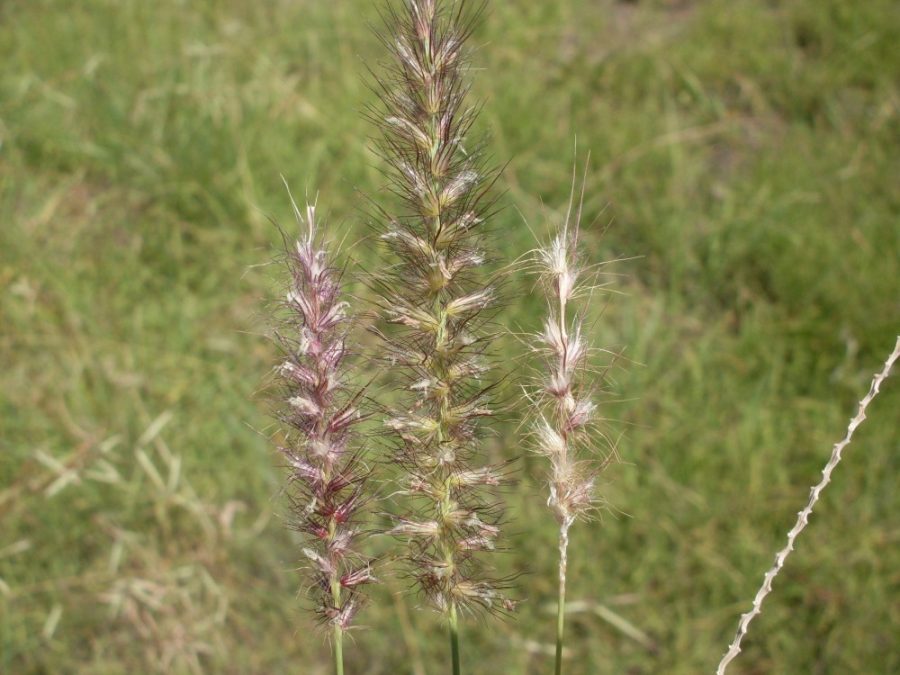Ever bite into a cookie thinking it was chocolate chip only to find out the “chocolate chips” were actually raisins? Buffelgrass is that cookie. To an outsider, it looks just like part of the desert landscape, providing an illusion of a thriving ecosystem. But behind the scenes, it’s destroying the habitat of native plant species, such as Saguaro cacti, mesquites and palo verdes.
“There’s a lot of people, especially around Tucson, who have almost made it their life’s work to work at eliminating it [buffelgrass],” said Steve Smith, an associate professor in the UA School of Renewable Natural Resources and the Environment and the School of Plant Sciences.
What’s so bad about buffelgrass? The problem is fairly straight forward, according to Smith. Buffelgrass is a very aggressive, invasive species, and it’s also highly flammable. This is bad news for Tucson’s native plants.
“The desert has not had fire and what buffelgrass does is fill in those open spaces between our desert plants and provides a path of fuel for a fire to spread across the landscape,” said William McCloskey, an associate specialist in the School of Plant Sciences.
Buffelgrass burns extremely hot, and once a fire has passed through, it grows back at an even quicker rate and density, unlike native species, McCloskey said. Unfortunately, the risk of fire isn’t the only threat buffelgrass poses.
“As an invasive species, it has the potential to destroy the Sonoran Desert, to convert it to another type of plant community,” McCloskey said. “It could transform the way Tucson looks in the future.”
If you’ve ever been hiking in the Sonoran Desert, you’ve probably noticed how most of the ground has very little vegetation on it, McCloskey said. Buffelgrass takes advantage of that open space, extracting the moisture the native vegetation would have used. In a period of about 10 years, native plant species can be completely eradicated in a buffelgrass-infested area, he said.
RELATED: UA scientists study effects of 2014 ‘pulse flow’ in the Colorado River delta
Buffelgrass was introduced to Arizona from East Africa and Southwestern Asia during the 1930s, Smith said.
“It was brought here to provide two things: one is conservation of the soil, sort of stabilizing the soil, but more importantly to provide plants for cattle to consume,” Smith said.
Unfortunately, by the time people realized the negative effects of buffelgrass in the 1980s, it had already spread throughout Southern Arizona.
Interestingly enough, if you were to ask someone in Texas if buffelgrass was a weed, they’d say of course not, because it’s an important source of feed for cattle, McCloskey said. The term “weed” is relatively subjective; what’s considered pasture grass in Texas is classified as a noxious weed in Arizona.
There are two main methods of eradicating buffelgrass. The most common method is to pull the buffelgrass out by hand, McCloskey said. This is highly effective when the infected area is reasonably sized, but when the buffelgrass covers a large amount of land, the use of chemicals is necessary.
According to Smith, there are two ways to apply herbicides to the buffelgrass. You can either use a backpack sprayer and cover the area on foot, spraying as you go, or you can use aerial applicators, such as helicopters. This is really the only option when you have a large infestation, Smith said.
“The chemical that Saguaro National Park has been applying is glyphosate, which is the active ingredient in Roundup,” McCloskey said. “What we find with Roundup is that our woody species in the desert and our cacti are fairly tolerant to glyphosate, so when we go out to spray buffelgrass once by air, we don’t seem to be harming the native vegetation.”
Smith adds that, while herbicides are not fail-safe, he feels confident in the safety and effectiveness of chemical weed management used by Pima County.
RELATED: Reid Park Zoo breaks ground animal health center
Pima County, the Arizona-Sonora Desert Museum and Tucson’s National Park services have been anxiously involved in the effort to eradicate buffelgrass for the past 20 years.
“I feel that, with concerted effort over the next decade or so, we could actually eliminate it in much of Pima County. It’s going to be dependent on climate, but it’ll also very dependent on decisions that people make and there are a lot of people, both in government as well as outside of government, that are very committed to this plant,” Smith said.
McCloskey added, “I think at this point, with the degree of how widespread buffelgrass is, you just have to be proactive and remove buffelgrass in the area around you, wherever you happen to be.”
If you want to be involved in the effort to eradicate buffelgrass, sign up for a Beat Back Buffelgrass Day or visit the Arizona-Sonora Desert Museum’s website for more information.
Follow Hannah Dahl on Twitter.









